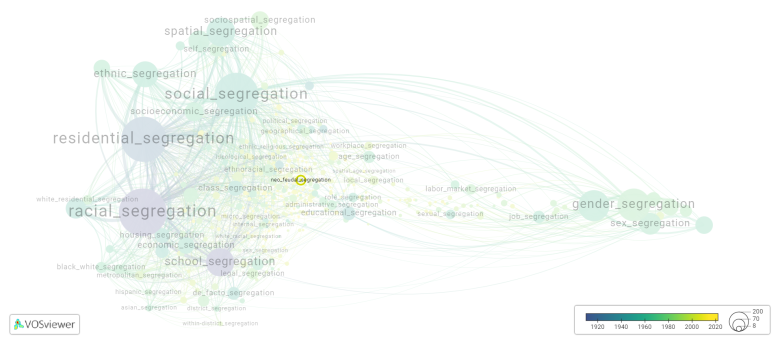Neo feudal segregation: Difference between revisions
(Creating page) |
(Creating page) |
||
| (7 intermediate revisions by the same user not shown) | |||
| Line 1: | Line 1: | ||
===== Date and country of first publication<ref>Date and country of first publication as informed by the Scopus database (December 2023).</ref>===== | |||
2015<br> | 2015<br> | ||
Turkey | Turkey | ||
===== Definition ===== | |||
Neo-feudal segregation refers to a hypothetical scenario where society reverts back to a feudal system, characterized by a social structure based on inherited social status and the stratification of society into different classes or castes, resulting in segregation based on class or caste. | Neo-feudal segregation refers to a hypothetical scenario where society reverts back to a feudal system, characterized by a social structure based on inherited social status and the stratification of society into different classes or castes, resulting in segregation based on class or caste. | ||
| Line 10: | Line 10: | ||
Neo-feudal segregation, if realized, would likely result in a rigid social hierarchy, limited social mobility, and unequal distribution of wealth and power. This scenario could potentially lead to widespread social unrest and inequality, as well as significant challenges in terms of human rights and social justice. | Neo-feudal segregation, if realized, would likely result in a rigid social hierarchy, limited social mobility, and unequal distribution of wealth and power. This scenario could potentially lead to widespread social unrest and inequality, as well as significant challenges in terms of human rights and social justice. | ||
==See also== | ==See also== | ||
==Related segregation forms== | |||
Neo feudal segregation is frequently discussed in the literature with the following segregation forms: | |||
[[social segregation]] | |||
[[File:neo_feudal_segregation.png|780x780px]] | |||
This visualization is based on the study [[Segregation_Wiki:About| The Multidisciplinary Landscape of Segregation Research]]. | |||
For the complete network of interrelated segregation forms, please refer to: | |||
* [https://tinyurl.com/2235lkhw First year of publication] | |||
* [https://tinyurl.com/2d8wg5n3 Louvain clusters] | |||
* [https://tinyurl.com/223udk5r Betweenness centrality] | |||
* [https://tinyurl.com/244d8unz Disciplines in which segregation forms first emerged (Scopus database).] | |||
==References== | ==References== | ||
==Notes== | ==Notes== | ||
<references /> | <references /> | ||
{{NoteAI}} | {{NoteAI}} | ||
== | ==Neo feudal segregation appears in the following literature== | ||
Erhan Bağcı Ş. (2015) | Erhan Bağcı Ş. (2015). Decline of meritocracy: Neo feudal segregation in Turkey. ''Journal for Critical Education Policy Studies'', ''13''(2), 348-370. Institute for Education Policy Studies.https://doi.org/ | ||
Latest revision as of 07:17, 16 October 2024
Date and country of first publication[1][edit | edit source]
2015
Turkey
Definition[edit | edit source]
Neo-feudal segregation refers to a hypothetical scenario where society reverts back to a feudal system, characterized by a social structure based on inherited social status and the stratification of society into different classes or castes, resulting in segregation based on class or caste.
In this scenario, the ruling class or nobility would have ownership and control over most of the resources, while the lower classes or peasants would have limited access to wealth and opportunities. Segregation would occur when people from different classes or castes are separated from each other in terms of living arrangements, access to education, employment opportunities, and social interactions.
Neo-feudal segregation, if realized, would likely result in a rigid social hierarchy, limited social mobility, and unequal distribution of wealth and power. This scenario could potentially lead to widespread social unrest and inequality, as well as significant challenges in terms of human rights and social justice.
See also[edit | edit source]
Related segregation forms[edit | edit source]
Neo feudal segregation is frequently discussed in the literature with the following segregation forms:
This visualization is based on the study The Multidisciplinary Landscape of Segregation Research.
For the complete network of interrelated segregation forms, please refer to:
References[edit | edit source]
Notes[edit | edit source]
- ↑ Date and country of first publication as informed by the Scopus database (December 2023).
At its current state, this definition has been generated by a Large Language Model (LLM) so far without review by an independent researcher or a member of the curating team of segregation experts that keep the Segregation Wiki online. While we strive for accuracy, we cannot guarantee its reliability, completeness and timeliness. Please use this content with caution and verify information as needed. Also, feel free to improve on the definition as you see fit, including the use of references and other informational resources. We value your input in enhancing the quality and accuracy of the definitions of segregation forms collectively offered in the Segregation Wiki ©.
Neo feudal segregation appears in the following literature[edit | edit source]
Erhan Bağcı Ş. (2015). Decline of meritocracy: Neo feudal segregation in Turkey. Journal for Critical Education Policy Studies, 13(2), 348-370. Institute for Education Policy Studies.https://doi.org/

